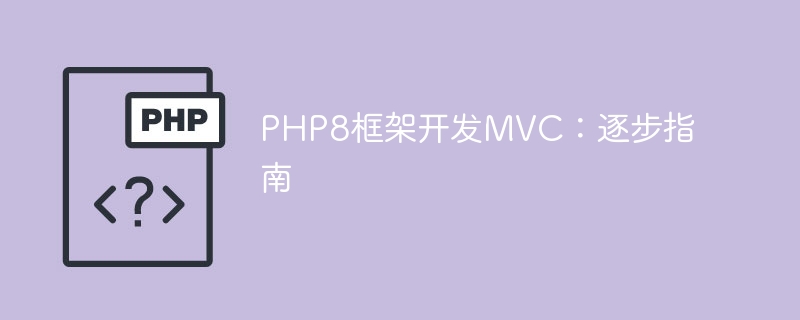

Developing MVC with PHP8 Framework: A Step-by-Step Guide
Introduction:
MVC (Model-View-Controller) is a commonly used software architecture pattern for Separation of application logic, data, and user interface. It provides a structure that separates the application into three distinct components for better management and maintenance of the code. In this article, we will explore how to use the PHP8 framework to develop an application that conforms to the MVC pattern.
Step one: Understand the MVC pattern
Before we start developing MVC applications, let's first understand the basic concepts of the MVC pattern. MVC consists of three components:
By separating the application logic, data and presentation logic, the MVC pattern can provide better code readability, maintainability and scalability.
Step 2: Choose PHP8 framework
When developing MVC applications, it is important to choose a suitable framework. PHP8 framework is a popular PHP framework with excellent performance and rich features. In addition, the PHP8 framework also provides good MVC support, making it easier for developers to organize and manage code.
Choose the PHP8 framework that suits you, and install and configure it.
Step 3: Create a model
In the PHP8 framework, creating a model is very simple. Usually, we store model files in the app/Models directory. Create a file called UserModel.php and define a UserModel class in it. In the model, we can write methods to interact with the database.
<?php
namespace AppModels;
class UserModel {
public function getAllUsers() {
// 从数据库获取所有用户数据的逻辑
}
public function getUserById($userId) {
// 根据用户ID从数据库获取用户数据的逻辑
}
// 其他与数据库交互的方法...
}Step 4: Create a view
In the PHP8 framework, view files are usually stored in the resources/views directory. Create a file called users.blade.php and write the HTML template of the view in it. In the view, we can use the template engine provided by the framework to render dynamic data.
<!DOCTYPE html>
<html>
<head>
<title>用户列表</title>
</head>
<body>
<h1>用户列表</h1>
<ul>
@foreach($users as $user)
<li>{{ $user->name }}</li>
@endforeach
</ul>
</body>
</html>Step 5: Create a controller
In the PHP8 framework, controller files are usually stored in the app/Controllers directory. Create a file called UserController.php and define a UserController class in it. In the controller, we can write routing and specific logic.
<?php
namespace AppControllers;
use AppModelsUserModel;
class UserController {
public function getAllUsers() {
$userModel = new UserModel();
$users = $userModel->getAllUsers();
return view('users', ['users' => $users]);
}
public function getUserById($userId) {
$userModel = new UserModel();
$user = $userModel->getUserById($userId);
return view('user', ['user' => $user]);
}
// 其他路由和逻辑...
}Step 6: Define routes
In the PHP8 framework, routing files are usually stored in the routes directory. In the routing file, we can define the access path and the corresponding controller method.
<?php
use AppControllersUserController;
$router->get('/users', [UserController::class, 'getAllUsers']);
$router->get('/users/{id}', [UserController::class, 'getUserById']);
// 其他路由...Step 7: Run the application
Run the application by executing the commands provided by the PHP8 framework, starting the web server, and accessing the routes we defined.
php -S localhost:8000 -t public
Conclusion:
In this article, we introduced in detail how to use the PHP8 framework to develop an application that conforms to the MVC pattern. By following the steps of the step-by-step guide, we can organize and manage the code more clearly, improve development efficiency, and make it easier to maintain. I hope this article will help you understand and use the PHP8 framework to develop MVC architecture applications.
The above is the detailed content of Developing MVC with PHP8 Framework: A Step-by-Step Guide. For more information, please follow other related articles on the PHP Chinese website!